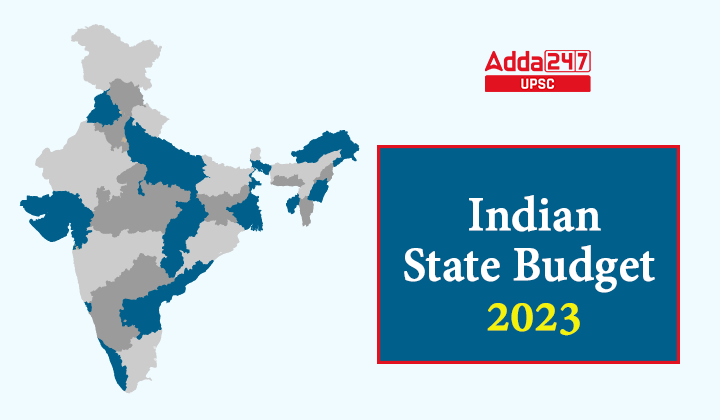Table of Contents
Indian State Budget 2023: State budgets are presented in the State Assembly or Vidhan Sabha by the State Finance Minister, just like the Union Budget is. The Indian State Budget process, which involves substantial prior work for budget preparation and execution, is a multi-step process, and this public presentation is just one part of it. Assessing the various sources and amounts of money a State Government can produce for its receipts budget is an essential first step.
Relevance for UPSC Prelims and Mains
Understanding state finances, fiscal deficits, revenue deficits, and debt ratios is crucial in comprehending government budgeting and fiscal policies, which are relevant areas for the Prelims examination.
India’s State Finances Context
In India, the States mobilize more than a third of the total revenue, accounting for 60% of combined government expenditure and approximately 40% of government borrowing. Understanding the finances of the States is crucial for drawing evidence-based inferences about the fiscal situation of the country. An analysis of the emerging fiscal situation of States based on key data from individual State budgets for 2023-24 reveals significant findings.
Fiscal Imbalance and Post-Pandemic Corrections
As the first quarter of the fiscal year 2023-24 concludes, it becomes evident that the increase in general government deficit and debt during the COVID-19 pandemic is receding. Both the Union and State levels have witnessed substantial post-pandemic fiscal corrections. At the Union level, the fiscal deficit declined from 9.1% of GDP in 2020-21 to 5.9% in 2023-24 (BE). Meanwhile, the fiscal deficit for all States was 4.1% of GDP in 2020-21, reducing to 3.24% in 2022-23 (RE). For the major States in 2023-24 (BE), it is expected to further decrease to 2.9% of GDP. This sharp reduction in fiscal deficit highlights the need for a comprehensive understanding of the fiscal situation, especially regarding State finances.
India’s State Finances Challenges
Unfortunately, due to the absence of aggregated data from individual State budgets, a consolidated view of general government finances is not readily available. The Reserve Bank of India’s (RBI) Annual Study on State Finances, which aggregates fiscal data from individual State budgets, is published in the second half of the fiscal year. To bridge this gap, an analysis based on data collated from the budgets of 17 major States, responsible for over 90% of combined State spending, provides insights into the fiscal issues emerging from their budgets.
India’s State Finances Analysis of Major States
The analysis reveals that these major States have successfully contained their fiscal deficits, showcasing significant fiscal consolidation. This consolidation is noteworthy for several reasons.
- First, despite a contraction in revenues during the peak of COVID-19, the States managed to be fiscally prudent.
- Second, addressing the emergency health and livelihood provisions during the pandemic required Union-State fiscal coordination.
- Third, the States swiftly reprioritized expenditures to contain the fiscal deficit.
- Fourth, the reduction in fiscal deficit stems from expenditure-side adjustments, improved Goods and Services Tax (GST) collections, and higher tax devolution due to buoyant central revenues.
- Fifth, most States are witnessing signs of recovery in non-GST revenues post-pandemic.
Successes and Prudence in State Finances Amidst COVID-19
However, there are significant fiscal challenges that need to be addressed in the short to medium term, with the most critical one being the containment of revenue deficits in the States. The reduction in fiscal deficit has not been accompanied by a corresponding reduction in revenue deficit. Out of the 17 major States, 13 have a deficit in the revenue account for 2023-24 (BE). Among these 13 States, the fiscal deficits of seven States, namely Andhra Pradesh, Haryana, Kerala, Punjab, Rajasthan, Tamil Nadu, and West Bengal, are primarily driven by revenue deficits. These States also have high debt-to-GSDP ratios.
India’s State Finances Fiscal Challenges
While the presence of a revenue deficit may not necessarily indicate fiscal profligacy, the increasing revenue deficits leading to fiscal imbalances have long-term financial implications that must be corrected. In 2023-24 (BE), the specific shares of revenue deficit in fiscal deficit for these seven States are as follows: Andhra Pradesh (40.9%), Haryana (50.9%), Kerala (60.4%), Punjab (70.7%), Rajasthan (39.7%), Tamil Nadu (40.8%), and West Bengal (47%). The all-State share of revenue deficit in fiscal deficit for the same year is expected to be 27%.
Framework for Addressing Revenue Deficit
To address the revenue deficit issue, a long-term view and incentive-compatible framework are necessary. One suggestion is to link interest-free loans provided by the Union Government to the States with a reduction in revenue deficits. This approach would prevent the substitution of States’ own capital spending and discourage the diversion of borrowed resources toward revenue expenditure. Additionally, establishing a defined time path for revenue deficit reduction, accompanied by a credible fiscal adjustment plan, would contribute to fiscal balance and improve the quality of expenditure.
India’s State Finances Conclusion
In conclusion, it is essential to refocus attention on managing revenue deficits. A macro view that considers the overall fiscal situation is crucial. By implementing measures to reduce revenue deficits and establishing a sustainable framework, India can ensure the fiscal stability of its state finances, ultimately fostering higher State-specific growth.
India’s State Finances Practice Question
“Discuss the significance of analyzing the fiscal situation of Indian states for drawing evidence-based inferences on the country’s overall fiscal stability. Examine the key challenges faced in managing revenue deficits in states and suggest suitable measures to address them. (Word limit: 200 words)”
| Follow US | |
| UPSC Govt. Jobs UPSC Current Affairs UPSC Judiciary PCS Download Adda 247 App here to get the latest updates |



 TSPSC Group 1 Question Paper 2024, Downl...
TSPSC Group 1 Question Paper 2024, Downl...
 TSPSC Group 1 Answer key 2024 Out, Downl...
TSPSC Group 1 Answer key 2024 Out, Downl...
 UPSC Prelims 2024 Question Paper, Downlo...
UPSC Prelims 2024 Question Paper, Downlo...





